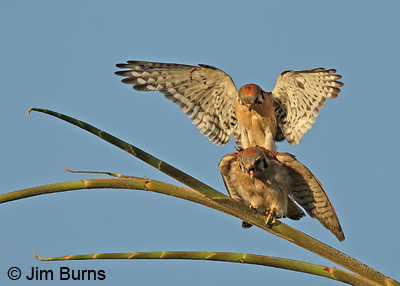
There have been 981 avian species recorded in North America. That’s a boatload of birds, way too many for even the most obsessed lister to know thoroughly. We all have favorite species, neighborhood specialties, and nemesis birds that we have researched and made the subject of our limited expertise, but even professional birders have gaps in their field experience and some species that just hold no special interest for them. For the casual birder, some rather common species can often fall into these gaps. How about American Kestrel?
Last month I discovered how little I knew about this most numerous, widespread, and well-studied North American falcon. If you’ve taken any long driving trips, you know kestrels as nifty little hawks that hunt from utility wires in open country. Other than that I only knew kestrels primarily from two separate photographic incidents, one frustrating, one unexpected. I had tried unsuccessfully for years before getting images of kestrels hover hunting, hanging in the air over field or marsh, peering down intently for their next meal of mouse or grasshopper. And then one day, completely unanticipated, I witnessed kestrel copulation--on top of a Saguaro, in the low desert, in early October!
Because I had always assumed Arizona’s kestrels bred in the spring and at slightly higher elevations somewhat farther north, I puzzled over this record for years, but never enough to do any research. I had a lot to learn. In late May I was hanging out early one evening near the fountain in our front yard hoping to catch one of our local Anna’s Hummingbirds coming in for that last drink or bath of the day. Catching movement above our roof atop the utility pole in the back alley, I was shocked to see an American Kestrel on the crossbeams. I had never seen a kestrel in the Valley in summer. It’s 6:00pm, over 100 degrees. They’re all up in the foothills or mountains on breeding territory, right?
Within the next minute four more kestrels, an adult female, two juvenile females, and a juvenile male, joined the adult male on the pole where they were immediately strafed by a hummingbird. Moving through the house to the backyard, I heard “killy, killy, killy” and realized at once all my assumptions about American Kestrels in the desert had been faulty. At 6:00am the next morning, hearing the family's vocalizations again, I stepped into the backyard and learned a lot more.
I witnessed the adult pair copulate in a palm tree down the alley as the juveniles watched from our utility pole. Then I had a front row seat as the utility pole became the family’s “splendid table.” First the adult male flew in with a House Sparrow which he reluctantly (or maybe he was trying to teach the young to be aggressive around food) shared with the offspring. The next item up was a House Finch, followed by thirty minutes of male and kids attempting, several times successfully, to capture and eat the flies attracted to the blood and guts remaining on the crossbeams from the main avian breakfast course.
As many of you probably already knew, and I know now, American Kestrels do nest in the Valley and are secondary cavity nesters often utilizing Gila Woodpecker and Gilded Flicker excavations in Saguaros (my next photo project, please call if you find one). There is an influx of migratory kestrels into the deserts in winter, but non-migratory resident pairs may stay together through the desert winter and may, as do many desert species, nest throughout the calendar year here. And for sure these efficient little killing machines, opportunistic as all birds of prey, will supplement their diet of insects and rodents with small birds whenever the chance occurs.
Do some research and expand your knowledge of all our avian desert neighbors. You may be surprised, as I was, at how much you don’t know.